Delphi › Demeter › Women in Ancient Greece » Origins and History
Articles and Definitions › Contents
- Delphi › Origins
- Demeter › Who Was
- Women in Ancient Greece › Origins
Ancient civilizations › Historical places, and their characters
Delphi › Origins
Definition and Origins
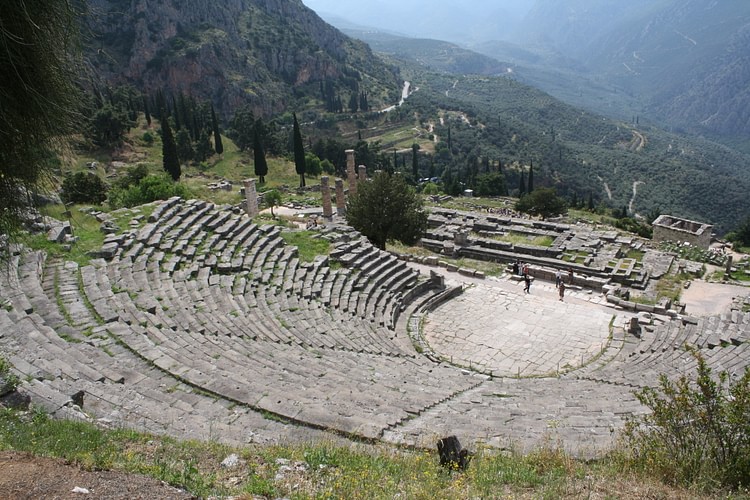
Delphi was an important ancient Greek religious sanctuary sacred to the god Apollo. Located on Mt. Parnassus near the Gulf of Corinth, the sanctuary was home to the famous oracle of Apollo which gave cryptic predictions and guidance to both city -states and individuals. In addition, Delphi was also home to the panhellenic Pythian Games.
MYTHOLOGY & ORIGINS
The site was first settled in Mycenaean times in the late Bronze Age (1500-1100 BCE) but took on its religious significance from around 800 BCE. The original name of the sanctuary was Pytho after the snake which Apollo was believed to have killed there. Votive offerings at the site from this period include small clay statues (the earliest), bronze figurines, and richly decorated bronze tripods.
FOR THE GREEKS DELPHI WAS CONSIDERED THE CENTRE OF THE WORLD.
Delphi was also considered the centre of the world, for in Greek mythology Zeus released two eagles, one to the east and another to the west, and Delphi was the point at which they met after encircling the world. This fact was represented by the omphalos (or navel), a dome-shaped stone which stood outside Apollo's temple and which also marked the spot where Apollo killed the Python.
APOLLO'S ORACLE
The oracle of Apollo at Delphi was famed throughout the Greek world and even beyond. The oracle - the Pythia or priestess - would answer questions put to her by visitors wishing to be guided in their future actions. The whole process was a lengthy one, usually taking up a whole day and only carried out on specific days of the year. First the priestess would perform various actions of purification such as washing in the nearby Castalian Spring, burning laurel leaves, and drinking holy water. Next an animal - usually a goat - was sacrificed. The party seeking advice would then offer a pelanos - a sort of pie - before being allowed into the inner temple where the priestess resided and gave her pronouncements, possibly in a drug or natural gas-induced state of ecstasy.
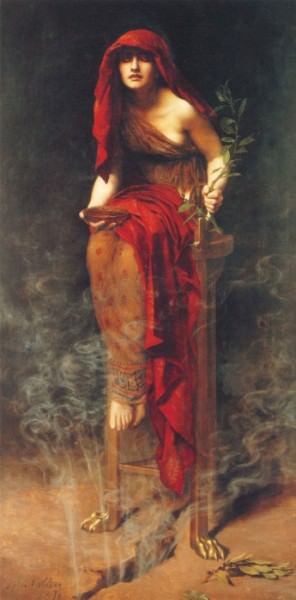
Pythia of the Oracle of Delphi
Perhaps the most famous consultant of the Delphic oracle was Croesus, the fabulously rich King of Lydia who, faced with a war against the Persians, asked the oracle's advice. The oracle stated that if Croesus went to war then a great empire would surely fall. Reassured by this, the Lydian king took on the mighty Cyrus. However, the Lydians were routed at Sardis and it was the Lydian empire which fell, a lesson that the oracle could easily be misinterpreted by the unwise or over-confident.
PANHELLENIC GAMES
Delphi, as with the other major religious sites of Olympia, Nemea, and Isthmia, held games to honour various gods of the Greek religion. The Pythian Games of Delphi began sometime between 591 and 585 BCE and were initially held every eight years, with the only event being a musical competition where solo singers accompanied themselves on a kithara to sing a hymn to Apollo. Later, more musical contests and athletic events were added to the programme, and the games were held every four years with only the Olympic Games being more important. The principal prize for victors in the Games was a crown of laurel or bay leaves.
The site and games were managed by the independent Delphic amphictiony - a council with representatives from various nearby city-states - which levied taxes, collected offerings, invested in construction programmes, and even organised military campaigns in the Four Sacred Wars, fought to redress sacrilegious acts against Apollo perpetrated by the states of Crisa, Phocis, and Amphissa.
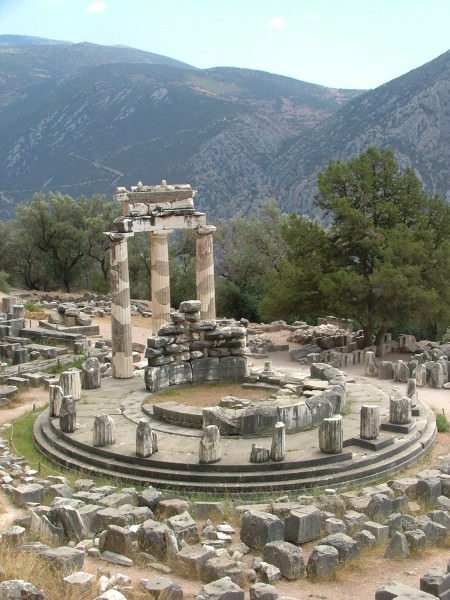
Tholos of Delphi
ARCHITECTURE
The first temple in the area was built in the 7th century BCE and was itself a replacement for less substantial buildings of worship which had stood before it. The focal point of the sanctuary, the Doric temple of Apollo, was unfortunately destroyed by fire in 548 BCE. A second temple, again Doric in style, was completed in c. 510 BCE with the help of the exiled Athenian family, the Alcmeonids. Measuring some 60 by 24 metres, the facade had six columns whilst the sides had 15. This temple was destroyed by earthquake in 373 BCE and was replaced by a similarly proportioned temple in 330 BCE. This was constructed with poros stone coated in stucco. Marble sculpture was also added as decoration along with Persian shields taken at the Battle of Marathon. This is the temple which survives, albeit only partially, today.
Other notable constructions at the site were the theatre (with capacity for 5,000 spectators), temples to Athena (4th century BCE), a tholos with 13 Doric columns (c. 580 BCE), stoas, stadium (with capacity for 7,000 spectators), and around 20 treasuries, which were constructed to house the votive offerings and dedications from city-states all over Greece. Similarly, monuments were also erected to commemorate military victories and other important events. For example, the Spartan general Lysander erected a monument to celebrate his victory over Athens at Aegospotami. Other notable monuments were the great bronze Bull of Corcyra (580 BCE), the ten statues of the kings of Argos (c. 369 BCE), a gold four-horse chariotoffered by Rhodes, and a huge bronze statue of the Trojan Horse offered by the Argives (c.413 BCE). Lining the sacred way, which wound from the sanctuary gate up to the temple of Apollo, the visitor must have been greatly impressed by the artistic and literal wealth on display. Alas, in most cases, only the monumental pedestals survive of these great statues, silent witnesses to a lost grandeur.
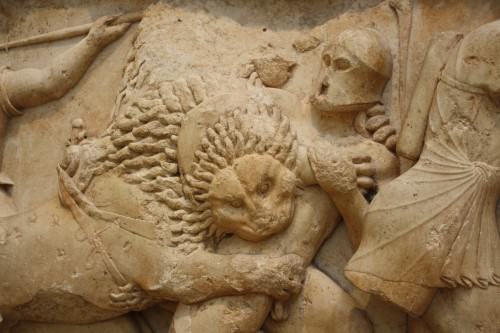
Gigantomachy of Delphi
DEMISE
In 480 BCE the Persians attacked the sanctuary and in 279 BCE the sanctuary was again attacked, this time by the Gauls. It was during the 3rd century BCE that the site came under the control of the Aitolian League. In 191 BCE Delphi passed into Roman hands; however, the sanctuary and the games continued to be culturally important in Roman times, in particular under Hadrian. The decree by Theodosius in 393 CE to close all pagan sanctuaries resulted in Delphi's gradual decline. A Christian community dwelt at the site for several centuries until its final abandonment in the 7th century CE.
The site was 're-discovered' with the first modern excavations being carried out in 1880 CE by a team of French archaeologists. Notable finds were splendid metope sculptures from the treasury of the Athenians (c. 490 BCE) and the Siphnians (c. 525 BCE) depicting scenes from Greek mythology. In addition, a bronze charioteer in the severe style (480-460 BCE), the marble Sphinx of the Naxians (c. 560 BCE), the twin marble archaic statues - the kouroi of Argos (c. 580 BCE) and the richly decorated omphalos stone (c. 330 BCE) - all survive as testimony to the cultural and artistic wealth that Delphi had once enjoyed.
The site was 're-discovered' with the first modern excavations being carried out in 1880 CE by a team of French archaeologists. Notable finds were splendid metope sculptures from the treasury of the Athenians (c. 490 BCE) and the Siphnians (c. 525 BCE) depicting scenes from Greek mythology. In addition, a bronze charioteer in the severe style (480-460 BCE), the marble Sphinx of the Naxians (c. 560 BCE), the twin marble archaic statues - the kouroi of Argos (c. 580 BCE) and the richly decorated omphalos stone (c. 330 BCE) - all survive as testimony to the cultural and artistic wealth that Delphi had once enjoyed.
Demeter › Who Was
Definition and Origins
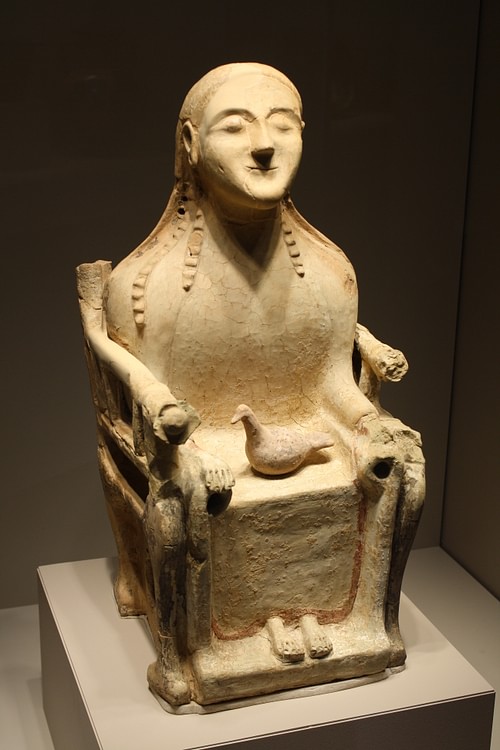
One of the oldest Greek gods, Demeter ( Roman name: Ceres) guaranteed the fertility of the earth and protected farming and vegetation. This close connection with the earth was inherited from her mother Rhea, and doubtless she was a reincarnation of local mother-Earth goddesses, commonly worshipped in rural communities.
DEMETER'S FAMILY
Daughter of Kronos and Rhea, sister of Zeus, Poseidon, Hades, Hera, and Hestia, Demeter was the mother of Persephone and Iacchus (both with Zeus) and Pluto, the god of wealth (with Iasion, who was subsequently killed by a thunderbolt from a jealous Zeus). She also adopted Triptolemus, the Eleusinian prince, who gave the human race the gifts of the plough and knowledge of agriculture. Demeter was also pursued by Poseidon and to escape his attentions, she changed into a mare; however, Poseidon too changed into a horse and their resulting offspring was Arion, the winged horse ridden by Hercules.
Homer in The Iliad describes the goddess as 'golden-haired', and Hesiod in his Theogony and Works & Days, describes her as 'bounteous Demeter', 'well-garlanded', 'hallowed', and 'reverend'.
DEMETER AND PERSEPHONE WERE THE SUBJECT OF A MAJOR CULT IN THE ANCIENT GREEK WORLD.
DEMETER & PERSEPHONE
Demeter and Persephone (also known as Kore in Greek and Proserpina by the Romans) were the subject of a major cult in the ancient Greek world. According to mythology, Hades, god of the underworld, fell in love with Persephone as soon as he saw her and carried her off in his chariot to live with him in Hades. In some accounts Zeus had given his consent to the abduction, the location of the crime being traditionally placed in either Sicily (famed for its fertility) or Asia. Demeter searched the earth for her lost daughter and though Helios (or Hermes ) told her of her daughter's fate, she, nevertheless, continued her wanderings until she finally arrived at Eleusis. It was here, disguised as an old woman, that the goddess cared for Demophon (or Triptolemus), the only son of Metaneira, the wife of Keleos, king of Eleusis. To reward the family for their kindness, Demeter set about making Demophon immortal by placing him on a fire every night. However, when Metaneira saw this she raised an alarm. In response, Demeter revealed her true identity and demanded a temple be built in her honour. This was the beginning of the celebrated sanctuary of Eleusis.

Demeter and Persephone
Once the temple was completed, Demeter withdrew from the world and lived inside it; at the same time she created a great drought to convince the other gods to release Persephone from Hades. As the drought claimed ever more victims, Zeus finally persuaded Hades to release his ill-gotten bride. Before giving her up though, the wily Hades put a pomegranate kernel in the girl's mouth, knowing its divine taste would compel her to return to him. In other versions of the myth, Persephone could have been released if she had not eaten anything in the underworld during her captivity, but at the last moment, Hades gave her a pomegranate seed. Finally, as a compromise, it was decided that Persephone would be released but that she would have to return to Hades for one third of the year (or in other accounts one half).
The story of Demeter and Persephone was perhaps symbolic of the changing seasons and the perennial change from life to death, to life once more, or in other words, the changes from summer to winter and the return of life in spring. The cycle became one of the rituals of the sacred Eleusinian mysteries; indeed the symbols of the cult were ears of corn and a torch - symbolic of Demeter's search for Persephone and a reminder that the rituals were carried out at night. As all initiates were bound by a sacred oath not to reveal the details of the mysteries, they have to this day remained just that, a mystery.

Pheneos Silver Stater
The most important sanctuary to Demeter, then, was at Eleusis in Attica which had religious origins and monuments dating back to the Mycenaean civilization of the 15th century BCE. Eleusis became a truly pan - Hellenic site under the dictator Peisistratus and continued to be visited in Roman times. From the 8th century BCE there was also a sanctuary and temple to Demeter on Naxos, in the 4th century BCE a temple was constructed in her honour at Dion, and Homer mentions that the goddess had a precinct named after her at Pyrasos.
DEMETER IN ART
Demeter rarely appears in art before the 6th century BCE and then she is usually shown with Persephone; often both wear crowns and hold a torch, sceptre or stalks of grain. Demeter is also sometimes present in scenes depicting the birth of Athena.
Women in Ancient Greece › Origins
Ancient Civilizations
Women in the ancient Greek world had few rights in comparison to male citizens. Unable to vote, own land, or inherit, a woman's place was in the home and her purpose in life was the rearing of children. This, though, is a general description, and when considering the role of women in ancient Greece one should remember that information regarding specific city -states is often lacking, is almost always from male authors, and only in Athens can their status and role be described in any great detail. Neither are we sure of the practical and everyday application of the rules and laws that have survived from antiquity. We do know that Spartan women were treated somewhat differently than in other states. For example, they had to do physical training like men, were permitted to own land, and could drink wine.
There were also categories of women which are less well-documented than others such as professional women who worked in shops and as prostitutes and courtesans; the social rules and customs applied to them are even more vague than for the female members of citizen families. Finally, in contrast to the lot of most women, some exceptionally and exceptional, rose above the limitations of Greek society and gained lasting acclaim as poets ( Sappho of Lesbos ), philosophers (Arete of Cyrene ), leaders ( Gorgo of Sparta and Aspasia of Athens), and physicians (Agnodice of Athens).
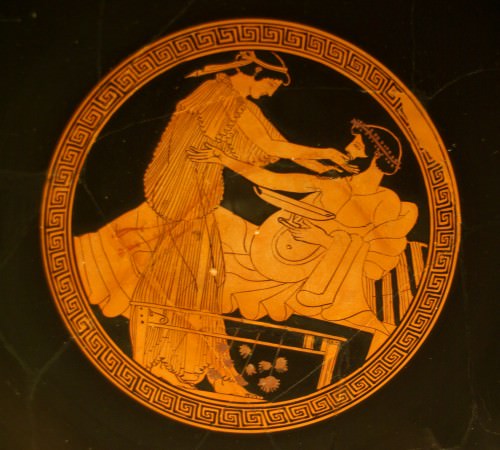
Symposiast & Hetairai
WOMEN IN MYTHOLOGY
Considering their limited role in actual society there is a surprisingly strong cast of female characters in Greek religion and mythology. Athena, the goddess of wisdom and patron of Athens stands out as a powerful figure blessed with intelligence, courage and honour. Again common to most ancient cultures where agriculture was crucial to the community, female fertility goddesses were extremely important and particularly venerated - Demeter and Persephone being the most revered for the Greeks.
As in other ancient male-dominated literature, women are often cast as troublemakers, from jealous Hera to Aphroditeemploying her charms to make men lose their wits. Myths and literature abound with female characters trying their best to derail the plans of male heroes, from the supreme witch Medea to the deadly, if lovely, Sirens. They can also be represented as ruled only by wild passion and ecstatic emotion such as the Maenads. In contrast, the ideal chaste woman loyal to her absent husband is epitomised by Penelope in Homer ’s Odyssey. The Muses are another positive representation, celebrated not only for their physical beauty but also their wide-ranging skills in the arts. Whether these fictional characters had any bearing on the role of women in real life is an open question, as is the more intriguing one of what did Greek women themselves think of such male-created role-models? Perhaps we will never know.
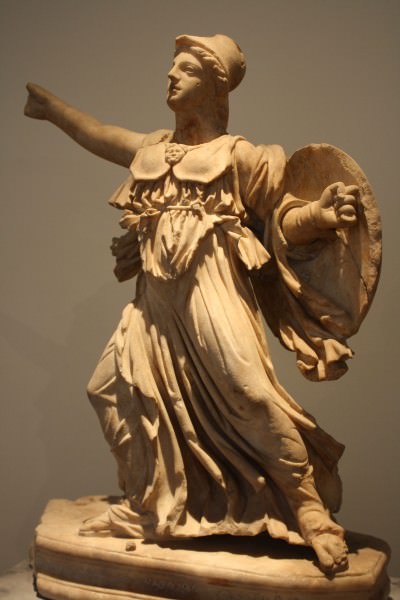
Athena (after the East pediment of the Parthenon)
GIRLS
As in many other male-dominated and agrarian cultures, female babies were at a much higher risk of being abandoned at birth by their parents than male offspring. Children of citizens attended schools where the curriculum covered reading, writing, and mathematics. After these basics were mastered, studies turned to literature (for example, Homer), poetry, and music (especially the lyre ). Athletics was also an essential element in a young person's education. Girls were educated in a similar manner to boys but with a greater emphasis on dancing, gymnastics, and musical accomplishment which could be shown off in musical competitions and at religious festivals and ceremonies. The ultimate goal of a girl's education was to prepare her for her role in rearing a family and not directly to stimulate intellectual development.
THE GOAL OF A GIRL'S EDUCATION WAS TO PREPARE HER FOR HER ROLE IN REARING A FAMILY & NOT TO STIMULATE INTELLECTUAL DEVELOPMENT.
An important part of a girl's upbringing involved pederasty (it was not only practised by mature males and boys). This was a relationship between an adult and an adolescent which included sexual relations but in addition to a physical relationship, the older partner acted as a mentor to the youth and educated them through the elder's worldly and practical experience.
YOUNG WOMEN
Young women were expected to marry as a virgin, and marriage was usually organised by their father, who chose the husband and accepted from him a dowry. If a woman had no father, then her interests (marriage prospects and property management) were looked after by a guardian ( kyrios or kurios ), perhaps an uncle or another male relative. Married at the typical age of 13 or 14, love had little to do with the matching of husband and wife ( damar ). Of course, love may have developed between the couple, but the best that might be hoped for was philia - a general friendship/love sentiment; eros, the love of desire, was often sought elsewhere by the husband. All women were expected to marry, there was no provision and no role in Greek society for single mature females.
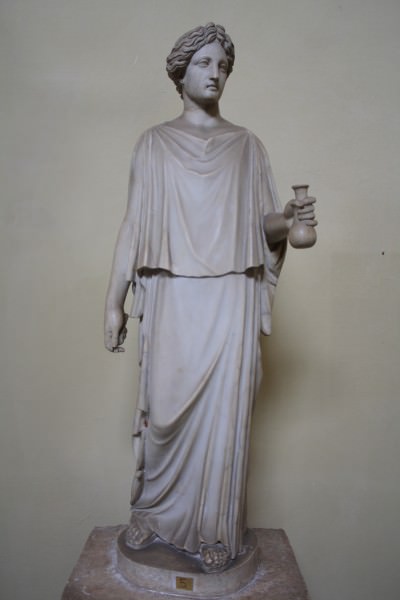
Greek Peplos Dress
MARRIED WOMEN
In the family home, women were expected to rear children and manage the daily requirements of the household. They had the help of slaves if the husband could afford them. Contact with non-family males was discouraged and women largely occupied their time with indoor activities such as wool-work and weaving. They could go out and visit the homes of friends and were able to participate in public religious ceremonies and festivals. Whether women could attend theatre performances or not is still disputed amongst scholars. More clear is that women could not attend public assemblies, vote, or hold public office. Even a woman's name was not to be mentioned in public – for good reasons or bad.
Married women were, at least in the eyes of the law, under the complete authority of their husbands. Such writers as Aristotlehave no doubts that women were intellectually incapable of making important decisions for themselves. In practice, of course, individual couples may well have shared their lives more equitably. Women were expected to be faithful to their husbands, but the reverse was not the case as husbands could freely engage the services of prostitutes, live-in lovers, and courtesans. Any woman who did not preserve the honour of the family (and so protect the legitimacy of the male line) was guilty of the serious crime of moicheia which would lead to her being banned from practising in public religious ceremonies. A husband who discovered that their wife was engaging in sexual relations with another man could murder the lover without fear of prosecution.
If a woman's father died, she usually inherited nothing if she had any brothers. If she were a single child, then either her guardian or husband, when married, took control of the inheritance. In some cases when a single female inherited her father's estate, she was obliged to marry her nearest male relative, typically an uncle. Females could inherit from the death of other male relatives, providing there was no male relative in line. Women did have some personal property, typically acquired as gifts from family members, which was usually in the form of clothes and jewellery. Women could not make a will and, on death, all of their property would go to their husband.
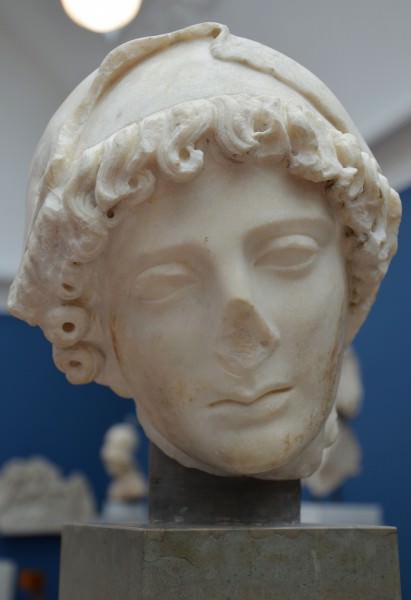
Head of Penelope
Marriages could be ended on three grounds. The first and most common was repudiation by the husband ( apopempsis or ekpempsis ). No reason was necessary, only the return of the dowry was expected. The second termination cause was the wife leaving the family home ( apoleipsis ), and in this case, the woman's new guardian was required to act as her legal representative. This was, however, a rare occurrence, and the woman's reputation in society was damaged as a result. The third ground for termination was when the bride's father asked for his daughter back ( aphairesis ), probably to offer her to another man with a more attractive dowry. This last option was only possible, however, if the wife had not had children. If a woman was left a widow, she was required to marry a close male relative in order to ensure property stayed within the family.
OTHER ROLES
Women, of course, were also present in the various other non-citizen classes. As slaves, they would have performed all manner of duties and they would also have worked in businesses such as shops and bakeries. The group for which we have most information is that of sex-workers. Women were here divided into two categories. The first and perhaps most common was the brothel prostitute ( pornē ). The second type was the higher-class prostitute ( hetaira ). These latter women were educated in music (especially the flute) and culture and often formed lasting relationships with married men. It was also this class of women that entertained men (in every sense) at the celebrated symposium, the private drinking party for male guests only.
Finally, some women participated in cults and performed as priestesses to certain female deities (Demeter and Aphrodite especially) and also Dionysos. Priestesses, unlike their male counterparts, did have the added restriction that they were often, but not always, selected because they were virgins or beyond menopause. Worshippers, on the other hand, could be both sexes, and those rituals with restrictions could exclude either men or women. The Thesmophoria fertility festival was the most widespread such event and was only attended by married women. Each year in Athens, four young women were selected to serve the priestess of Athena Polias and weave the sacred peplos robe which would adorn the cult statue of the goddess. Perhaps the most famous female religious role was the aged Pythia oracle at Delphi who interpreted the proclamations of Apollo.
LICENSE
Article based on information obtained from these sources:with permission from the Website Ancient History Encyclopedia
Content is available under License Creative Commons: Attribution-NonCommercial-ShareAlike 3.0 Unported. CC-BY-NC-SA License